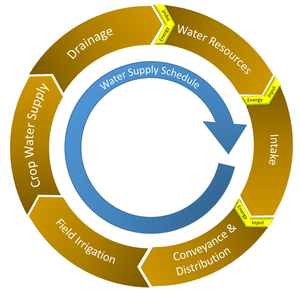SPIS Toolbox - Introduction

| ►Back to the Start Page | ►Back to the Module Page | ►Go to the Next Chapter |
1. Introduction
Irrigation is essential for food security and rural development
Globally, irrigated agriculture accounts for about 70 percent of water withdrawals, making it the largest water user. Irrigated agriculture provides approximately 40 percent of the world’s food, including most of its horticultural output, from an estimated 20 percent of agricultural land, or about 300 million ha worldwide (FAO 2011). Most future growth in crop production in developing countries is likely to come from intensification with irrigation increasingly playing a strategic role (AQUASTAT).
In many countries around the world, irrigation has had direct benefits on productivity and food security, typically producing food at higher cropping intensities and at least twice the yields of nearby rainfed crops (Faurès et al. 2007). It can reduce dependency on rainfed agriculture in drought-prone areas and increase cropping intensities in humid and tropical zones by ‘extending’ the wet season and introducing effective means of water control. As such, irrigation is often seen as the engine that drives rural development, producing food, providing job opportunities and generating income.
Nevertheless, irrigation has also been associated with negative environmental impacts, including a reduction in water flows, changes in downstream access to water, increased soil salinity or reduction of wetlands that provide important ecological functions for biodiversity, nutrient retention, and flood control. Related changes in land use and unsustainable resources management can lead to quality deterioration and depletion of water resources and associated ecosystems, upon which livelihoods depend.
Moreover, the water quality used for irrigation influences the yield and quantity of crops as well as soil permeability and productivity, and overall ecosystem health. Despite this, water scarcity and pollution levels are so significant in many parts of the world that millions of farmers are driven to irrigate with marginal quality water, such as urban wastewater or saline agricultural drainage water.
The impacts of climate change are already affecting irrigated agriculture as water demand is increasing, crop productivity is reducing, and water availability is becoming more limited in exactly those parts of the world where irrigation is most needed or has a clear comparative advantage.
What makes a good solar powered irrigation system?
Solar-powered irrigation is typically introduced as a new system, or when an already existing system is being modernised. In the latter case, solar energy replaces conventional forms of energy with photovoltaics (PV). Pumps powered by solar energy may be used to withdraw surface or groundwater resources.
When designing a Solar-Powered Irrigation System (SPIS), it is crucial that the full cycle of the water supply system is taken into account (Figure 1). This includes the water resources, water intake, conveyance and distribution, field irrigation methods, crop water supply, and drainage. Energy in the water supply system stems from the intake, conveyance, and distribution sections via pumping, lifting, and transporting.
Examining these elements, this module provides guidance on some of the key issues around planning and managing a solar powered irrigation system for agriculture.
Outcome/Product
- General introduction of the role of irrigation in agriculture and potential environmental impacts
- Overview of agricultural water supply system and energy inputs
Data Requirements
- Site data, including climate forecasts, farm location, topography, crop rotations desired, area of land to be irrigated, soil type
- Water data, including water quality, quantity, flow, depth and variability
- Information on the design/ layout of the irrigation system
People/Stakeholders
- Irrigation system designers & managers, water user groups or farmer organization
- Project managers
- Policy-makers
Important Issues
- Understand the linkage of the water and energy supply cycle
- Assess climate risks and understand the limitations that exist for the water supply system




















